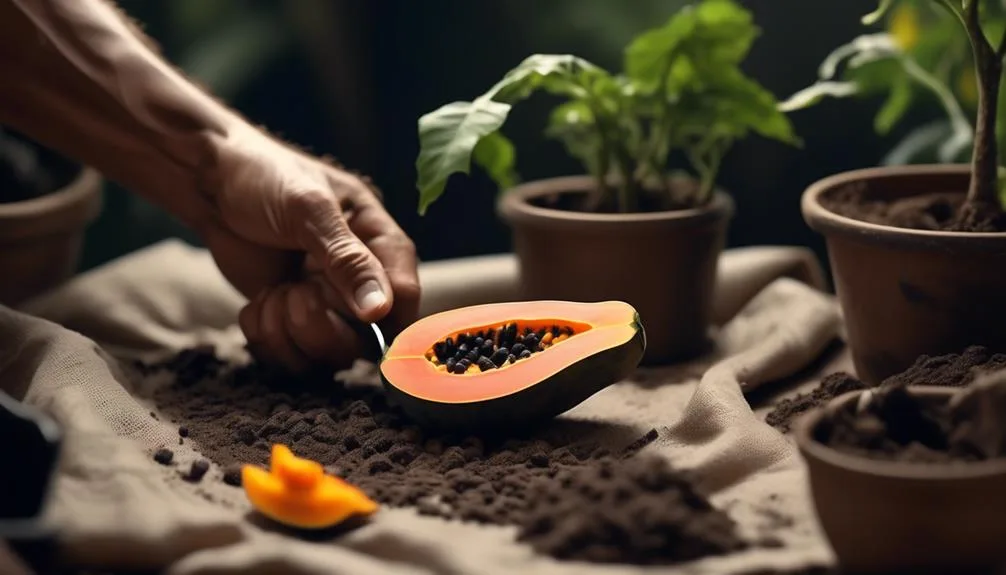Propagating papaya trees from seeds can be a fulfilling experience. Whether you're an experienced gardener or just starting out, growing papaya trees from seeds lets you witness nature's miracle firsthand.
If you're curious about this horticultural adventure, let's explore the steps to successfully propagate papaya trees from seeds and enjoy the fruits of your labor.
Key Takeaways
- Collect ripe papaya fruits with a yellow or orange hue and scoop out the seeds.
- Wash away the sticky coating from the seeds and allow them to dry for a few days.
- Plant the papaya seeds about 1/2 inch deep in well-draining potting mix and water consistently.
- Provide regular watering, sunlight, and fertilizer for healthy growth of papaya seedlings.
Selecting and Preparing Papaya Seeds
To ensure successful propagation, carefully select and prepare papaya seeds for optimal germination.
Start by collecting ripe fruits from a healthy papaya tree. Choose fruits that are fully mature, with a yellow or orange hue and a slightly soft texture.
Once you have collected the ripe fruits, it's time to extract the seeds. Scoop out the seeds from the fruit's cavity and wash away the sticky gelatinous coating.
After washing, spread the seeds out to dry on a paper towel for a few days. Make sure they're completely dry before storing them.
Planting Papaya Seeds
After ensuring your papaya seeds are thoroughly dry, prepare to plant them in a well-draining potting mix. Here's how to do it:
- Soil Preparation and Watering:
- Fill a pot with a well-draining potting mix, leaving about an inch of space at the top.
- Plant the papaya seeds about 1/2 inch deep in the soil.
- Water the soil thoroughly, ensuring it stays consistently moist but not waterlogged.
- Pest Control and Fertilization:
- Keep an eye out for pests like aphids and mites, which can be controlled with insecticidal soap.
- Once the seedlings have grown a few inches tall, start fertilizing with a balanced fertilizer every 2-3 months.
Providing Proper Care for Papaya Seedlings
Now that your papaya seeds have been planted and are starting to grow, it's important to provide proper care for the seedlings to ensure their healthy development.
Water the seedlings regularly, keeping the soil consistently moist but not waterlogged. Aim to water them every 2-3 days, adjusting based on the specific needs of your seedlings and the environmental conditions.
Additionally, ensure that your papaya seedlings receive adequate sunlight exposure. Place them in a location where they can receive at least 6 hours of sunlight per day. If you're growing the seedlings indoors, consider using a grow light to supplement sunlight.
Adequate watering and sunlight are crucial for the healthy growth of your papaya seedlings, so be attentive to these factors as they continue to develop.
Transplanting Papaya Seedlings
Consider transplanting your papaya seedlings once they've developed several sets of true leaves and are around 10-12 inches tall. To ensure a successful transplant, follow these essential tips:
- Soil Nutrition: Choose a well-draining soil mixture rich in organic matter. Mix compost or well-rotted manure into the soil to provide essential nutrients for the growing seedlings.
- Watering Frequency: Before transplanting, make sure the seedlings are well watered. After transplanting, water the seedlings gently and frequently to help them establish in their new environment. Keep the soil consistently moist, but not waterlogged, to promote healthy root development.
- Protection from Elements: Shield the newly transplanted seedlings from direct sunlight and strong winds for the first few days to minimize transplant shock.
Following these steps will help your papaya seedlings thrive in their new environment.
Maintaining and Harvesting Papaya Trees
To ensure the healthy growth and successful harvest of your papaya trees, proper maintenance and care are essential.
Regular watering, especially during dry spells, is crucial for papaya trees.
Apply a balanced fertilizer every 14 days to promote strong, healthy growth.
Prune your papaya trees regularly to remove dead or diseased branches and to maintain an open, vase-shaped canopy.
When it comes to harvesting techniques, wait until the papayas are fully ripened on the tree before picking them.
A ripe papaya will have a yellow color and yield slightly to gentle pressure.
Additionally, implement pest management strategies such as using organic pesticides or introducing beneficial insects to keep pests at bay.
Conclusion
Incorporate these simple steps to propagate papaya trees from seeds and soon you'll be enjoying the fruits of your labor.
- Carefully select and prepare the seeds.
- Provide proper care for the seedlings.
- Transplant them when they're ready.
With consistent maintenance and attention, you'll be on your way to growing your own homegrown papayas.
Happy planting!

